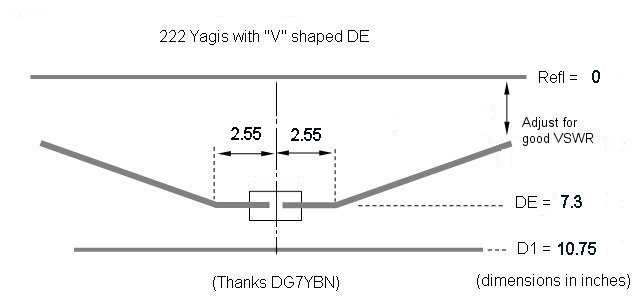

(updated 10 Oct 2016)
This particular antenna design was inspired by Hartmut DG7YBN and he was inspired by Günter DL6WU and Brian K6STI. His designs blend extremely high antenna gain, high G/T (which means a low noise temperature) along with a broad gain and VSWR bandwidth. The DE design is also very easy to build and allows adjustment of VSWR without significantly affecting the gain and pattern performance. A broad VSWR and gain bandwidth is ideally suited for wet and snow/ice climates where accumulation of moisture on the elements can lower the antennas resonant frequency and degrade performance.
In this design, I have scaled the 144-15V to 222 MHz and reoptimized at 222.1 MHz. In the 144-15V design, I adjusted the spacing and element lengths slightly to increase the Front/Rear to values over 30 dB in each plane. In the 222-15V design, the E-plane achieves an amazing 34.39 dB Front/Rear (all lobes from -90 to -180 degrees) and 31.3 dB Front/Rear in the H-plane at 222.1 MHz. This allows the antenna to reject terrestrial noise sources to an extremely high degree for improved EME performance in noisy locations. Element diameters are common US sizes (1/4" DE and 3/16" parasitics).
| Element | Cum Spacing (m) |
0.188" Element
Diameter Element Half-Lengths (m) Dielectric Boom or NEC simulation |
Element Full Lengths (inches) |
| Reflector | 0 | 0.330 | |
| Driven Element (0.250" OD) |
0.1855 | 0.318 | |
| D1 | 0.273 | 0.3122 | |
| D2 | 0.459 | 0.3093 | |
| D3 | 0.808 | 0.3018 | |
| D4 | 1.224 | 0.297 | |
| D5 | 1.705 | 0.2921 | |
| D6 | 2.218 | 0.2882 | |
| D7 | 2.750 | 0.2843 | |
| D8 | 3.300 | 0.2814 | |
| D9 | 3.853 | 0.2795 | |
| D10 | 4.393 | 0.2791 | |
| D11 | 4.926 | 0.2781 | |
| D12 | 5.443 | 0.2736 | |
| D13 | 5.933 | 0.2645 |

Comments are welcome!
contact Roger: email to
rgcox2 (at) gmail.com
Roger Cox - Spring Lake, MI